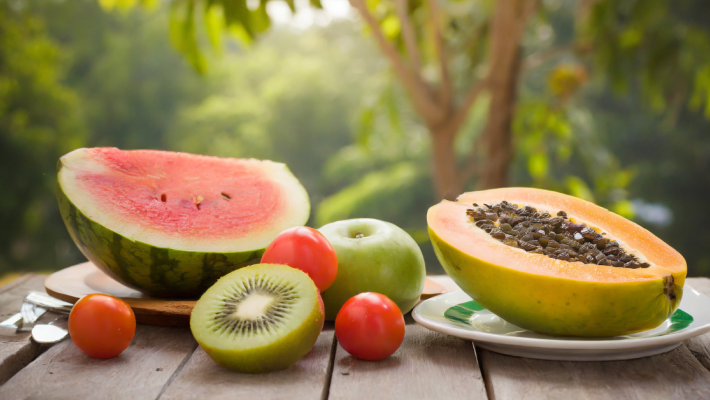Culinary Fruits
- €4,95
Distinctive Winter Pumpkin Variety With Sweet FleshThe Marina di Chioggia pumpkin is a remarkable heirloom winter pumpkin known for its unique green-grey pumpkin skin and bumpy texture. This Italian pumpkin cultivar produces flat-round fruits with...
- €4,95
Premium Marmande Beefsteak Tomato Seeds for GardenersDiscover the exceptional flavor of Marmande beefsteak tomato seeds, a prized Solanum lycopersicum variety known for its rich sweetness and juicy texture. This beefsteak tomato variety stands out for...
- €4,95
Sweet Orange Pineapple Melon Seeds for GreenhouseDiscover the vibrant flavor of Melon Orange Pineapple seeds, a tropical melon variety prized for its sweet orange flesh and refreshing taste. This Cucumis melo cultivar thrives in warm...
- €4,95
Premium Melon Seeds for Juicy Green FleshDiscover the delight of growing melon seeds from the Cucumis melo 'Ogen' variety, known for its luscious juicy green flesh. These melon seeds are ideal for indoor sowing and...
- €5,95
Flavorful Micro Cherry Tomato Seeds for ContainersDiscover the delight of cherry tomato seeds with the Micro Cherry Tomato variety, Solanum lycopersicum, known for its sweet, juicy fruits. These small fruit tomatoes produce long clusters of...
- €6,95
Flavorful Mini Orange Snack Paprika for Container GardeningDiscover the vibrant taste of the mini orange snack paprika, a delightful variety of Capsicum annuum perfect for container gardening and salad additions. These sweet orange snack peppers...
- €5,95
Mouse Melon Seeds for Fresh Cucumber Flavor FruitsDiscover the unique taste and charm of mouse melon seeds, perfect for gardeners seeking a refreshing twist in their summer harvest vegetables. The Melothria scabra produces small grape-sized...
- €4,95
Sweet Orange Pineapple Melon Seeds for Greenhouse CultivationDiscover the vibrant taste of Orange Pineapple Melon seeds, a delightful variety of Cucumis melo prized for its juicy, sweet fruit with bright orange flesh. These sweet melon...
- €4,95
Sweet Organic Watermelon Crimson Sweet SeedsDiscover the delight of Organic Watermelon Crimson Sweet seeds, known for their exceptional sweetness and vibrant dark red flesh. This Citrullus lanatus variety offers a long shelf life and impressive...
- €4,95
Vibrant Paprika Seeds for Home Garden PeppersDiscover the joy of growing paprika seeds with this colorful paprika seed mix featuring three distinct hues. This Capsicum annuum L. variety trio brings early maturing peppers perfect for...
- €4,95
Compact Paprika Seeds for Balcony and GreenhouseDiscover the versatility of paprika seeds from the Capsicum annuum Yolo Wonder variety, perfect for container gardening peppers and compact pepper plants. This sweet pepper variety produces fairly square...
- €5,95
Vibrant Paprika Seeds Mix for Greenhouse CultivationDiscover the paprika seeds mix featuring five distinct paprika varieties: Orange Horizon, Yellow Sunbright, Purple Bell, White Bell, and Yolo Wonder. This colorful paprika seeds collection offers a delightful...
- €6,95
Exotic Pepino Seeds for Indoor GrowingDiscover the unique appeal of pepino seeds (Solanum muricatum), an exotic choice for indoor fruit cultivation. The melon pear fruit is prized for its mild flavor, making it a versatile...
- €4,95
Productive Pepperone Goccia D'Oro Sweet Yellow PepperThe Pepperone Goccia D'Oro (Capsicum annuum L.) is a highly productive pepper plant known for its early harvest and vibrant golden-yellow fruits. This sweet yellow pepper variety features a...
- €5,95
Compact Plant Producing Deep Red Chili PeppersDiscover the vibrant flavor of Perona Red cherry pepper seeds, a hot variety of Capsicum annuum L. This compact pepper plant produces small red peppers with a rich, deep...
- €4,95
Delicious Spanish Sweet Melon with Toadskin RindThe Piel de Sapo melon seeds produce a unique melon variety known for its distinctive toadskin-patterned rind and sweet, juicy white flesh. This Spanish sweet melon is highly regarded...
- €4,95
Oval Sweet Fruit from Pink Thai Egg Tomato SeedsPink Thai Egg Tomato Seeds offer a unique addition to any garden with their distinctive oval-shaped fruits. This heirloom tomato variety produces cocktail tomatoes that mature from...
- €4,95
Sweet Orange Pointed Pepper Seeds for StuffingDiscover the vibrant flavor and versatility of pointed pepper seeds from the Capsicum annuum Timia Orange variety. These sweet pointed peppers feature bright orange fruits that grow up to...
- €4,95
Pomodoro Costoluto di Parma tomato plant featuresThe Pomodoro Costoluto di Parma tomato plant is an heirloom tomato variety celebrated for producing large fleshy tomatoes with an intense flavor. This early-ripening ribbed tomato plant yields strongly...
- €4,95
Pomodoro Pantano Tomato Seeds for Aromatic Beefsteak TomatoesDiscover the exceptional flavor of Pomodoro Pantano tomato seeds, a traditional Italian beefsteak tomato variety prized for its large, ribbed fruits and thick flesh. This Solanum Lycopersicum L....



























































